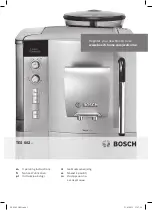
Setting the feed dog
Service Instructions 969 - 06.0 - 03/2019
47
Setting the stroke eccentric of the sewing feet
To set the stroke eccentric of the sewing feet (1):
1. Loosen the threaded pins on the stroke eccentric (1).
2. Insert the adjusting tube (3) into the first hole in the direction of
rotation (4).
3. Press the adjusting tube (3) against the front edge of the machine arm.
4. Set the handwheel to
23°
.
5. Tighten the threaded pins on the stroke eccentric (1).
Setting the pusher eccentric of the feed dog
To set the pusher eccentric of the feed dog (6):
1. Loosen the threaded pins on the pusher eccentric (6).
2. Insert the adjusting tube (3) into the first hole in the direction of
rotation (4).
3. Press the adjusting tube (3) against the front edge of the machine arm.
4. Set the handwheel to
230°
.
5. Tighten the threaded pins on the pusher eccentric (6).
Setting the stroke eccentric of the feed dog
To set the stroke eccentric of the feed dog (5):
1. Loosen the threaded pins on the stroke eccentric (5).
2. Insert the adjusting tube (3) into the first hole in the direction of
rotation (4).
3. Press the adjusting tube (3) against the front edge of the machine arm.
4. Set the handwheel to
5°
.
5. Tighten the threaded pins on the stroke eccentric (5).
Summary of Contents for 969 Classic
Page 1: ...969 Service Instructions...
Page 6: ...Table of Contents 4 Service Instructions 969 06 0 03 2019...
Page 10: ...About these instructions 8 Service Instructions 969 06 0 03 2019...
Page 92: ...Programming 90 Service Instructions 969 06 0 03 2019...
Page 106: ...Decommissioning 104 Service Instructions 969 06 0 03 2019...
Page 108: ...Disposal 106 Service Instructions 969 06 0 03 2019...
Page 119: ...Appendix Service Instructions 969 06 0 03 2019 117 21 Appendix Fig 76 Wiring diagram...
Page 120: ...Appendix 118 Service Instructions 969 06 0 03 2019...
Page 121: ......
















































